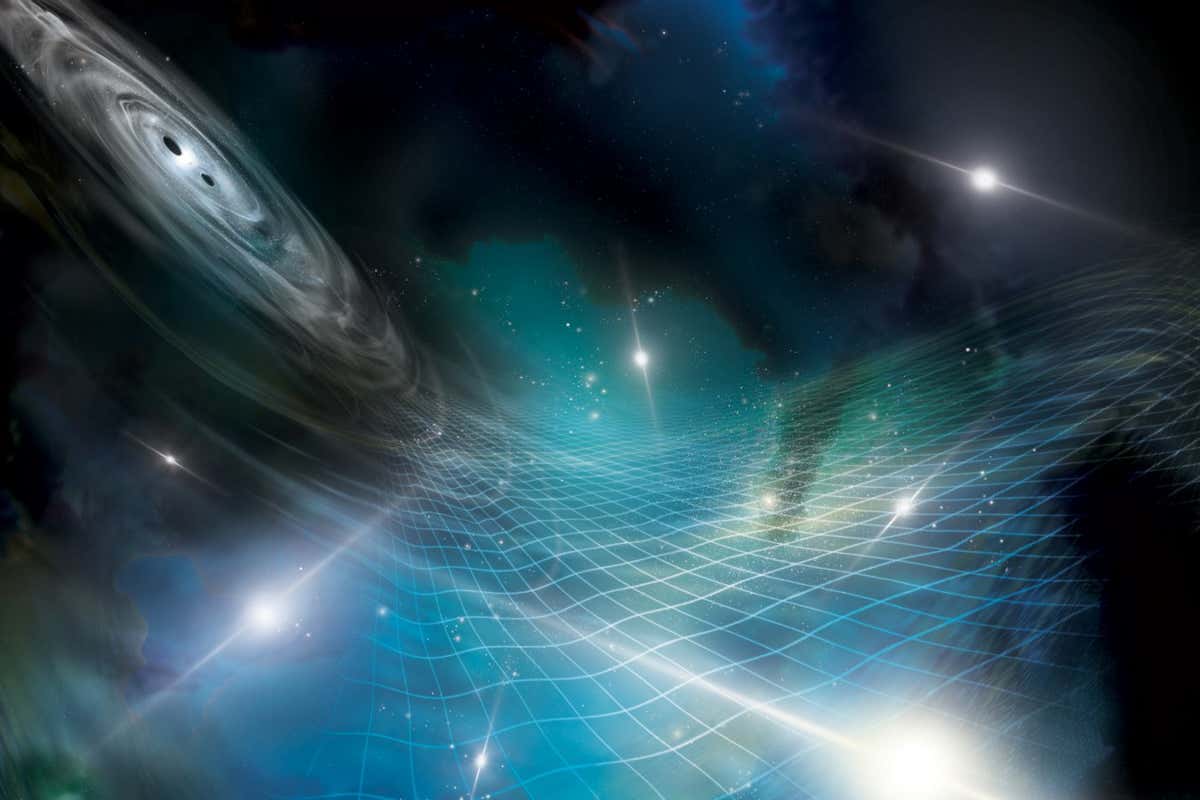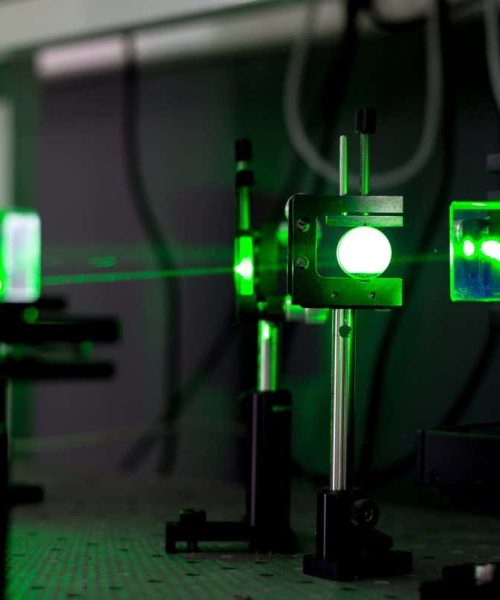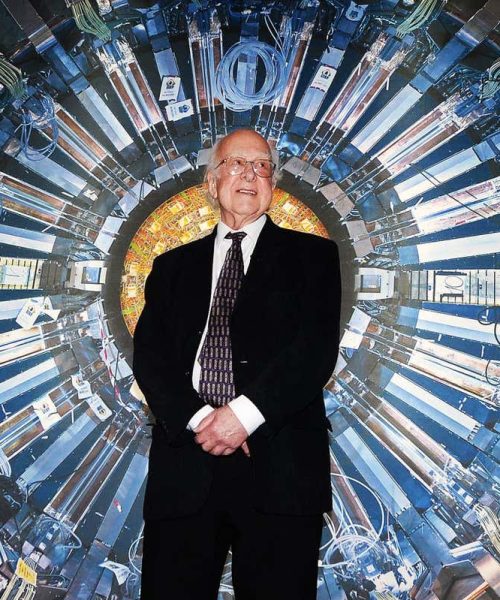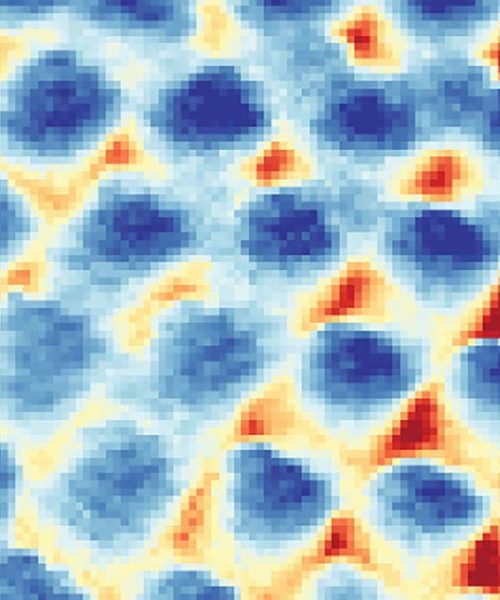
Pulsars have helped reveal ripples in space-time throughout the universe
NANOGrav
The fabric of the universe is constantly rippling, according to astronomers who have discovered a background buzz of gravitational waves. These waves may be produced by supermassive black holes merging across the universe, but they might also have more exotic origins, such as leftover ripples in space-time created shortly after the big bang. Pinning down their true nature could tell us about how supermassive black holes grow and affect their host galaxies, or even about how the universe evolved in its first moments.
To find this mysterious hum, astronomers have been tracking rapidly rotating neutron stars called pulsars that blast out light with extreme regularity. By looking at different pulsars across the Milky Way, astronomers can effectively use them as a galaxy-sized gravitational-wave detector called a pulsar timing array.
While individual gravitational waves, which are ripples in space-time created by massive objects colliding, have been seen regularly since the first detection in 2015, the object of this search is different. Those previous gravitational waves all have a localised origin and rise and fall hundreds of times a second, but the newly-discovered signal is more like a gravitational wave background that would permeate the entire universe at much lower frequencies, similar in concept to the cosmic microwave background, which is radiation left over by the big bang and seen all over the universe today.
Advertisement
In 2021, there were the first hints that the North American Nanohertz Observatory for Gravitational Waves (NANOGrav), a US-based collaboration that began in 2007 and that uses a pulsar timing array, had detected this gravitational wave background using radio telescopes.
By measuring the light signals from pulsars as they arrive at Earth and checking for tiny time fluctuations that may have been caused by ripples in space-time, astronomers thought they had found signs of a common process affecting all the pulsars’ timing in the same way. However, at that time they lacked a telltale signature predicted by Albert Einstein’s general theory of relativity that would confirm this cosmic-scale hum.

NANOGrav used the Green Bank Telescope in West Virginia
NANOGrav
Now, after a total 15 years of observations, the NANOGrav team has seen this signature in the signal for the first time, across a range of different gravitational wave frequencies. “It’s gone from a tantalising hint to something that is very strong evidence for the gravitational wave background,” says team member James McKee at the University of Hull, UK.
This hasn’t passed the statistical threshold that scientists need to call it a definite detection of the gravitational wave background, but astronomers are comfortable calling it very strong evidence, at a 3-sigma level of statistical significance, meaning the odds of such a signal cropping up in the absence of the gravitational wave background are around 1 in 1000.
Three other pulsar timing array (PTA) collaborations, consisting of Europe and India (EPTA), China (CPTA) and Australia (PPTA), have also released their results today. The CPTA claims to have found the gravitational wave background at an even higher confidence level than NANOGrav, but for only one frequency, while both EPTA and PPTA are seeing hints of it at a slightly weaker statistical level.
“They’re also starting to see this very characteristic correlation signal in their data,” says NANOGrav team member Megan DeCesar at George Mason University in Virginia. “We’re kind of all seeing it, which is very exciting because that suggests that it is probably real.”
Enormous scale
But confirming these signals and gaining more confidence in them isn’t straightforward, says Aris Karastergiou at the University of Oxford. “It’s on an enormous scale, with incredibly difficult data to work with.”
The gravitational wave background is minuscule — the strength of the signal that astronomers need to extract compared with the noise that is also picked up at the same time equates to one part in a quadrillion, while the gravitational waves themselves stretch around a light year – more than 9 trillion kilometres – over one wavelength. That is why pulsars, which are suitably spaced and are some of the most sensitive clocks in the universe, are key to this search. If a constant background of gravitational waves is distorting all space-time, then it should also affect all the pulsars’ light pulses in the same way, but measuring this isn’t easy, due to the many other factors that might affect the timing of the signals from each pulsar in the array.
“We have to be able to account for all of them and that takes a long time,” says McKee. “It takes a lot of years of observations, it takes a lot of understanding the noise properties of spin irregularities, the interstellar medium, things like that.”
It is only now that pulsar timing array teams feel confident enough in their data to be able to spot the distinctive pattern within the signal predicted by general relativity . As astronomers track pairs of pulsars in the sky, the timing differences in the light from them should become broadly less similar as the angle between them grows. This is because the light from pulsars that appear close in the sky will have travelled a similar route to Earth, meaning it experiences a similar path through the gravitational wave background, while light from those that appear further apart will take different paths.
Thanks to a quirk of general relativity, this relationship actually reverses for pulsars that are very separated, with the timing differences becoming more similar as you compare pulsars on opposite sides of the sky. This full pattern can be described using a graph called the Hellings-Downs curve, and it is this pattern that NANOGrav was missing in 2021.
“They couldn’t characterise it specifically and say, yes, it’s gravitational waves,” says Carlo Contaldi at Imperial College London. “But now that they’ve measured this Hellings-Downs curve, that’s really just a smoking gun.”
Competing explanations
So, assuming the signal remains as astronomers gather more data, what is causing the gravitational wave background?
The leading explanation involves pairs of merging supermassive black holes (SMBH), the gargantuan black holes at the centre of many galaxies with masses millions of times that of the sun. Once these objects are locked into orbit around each other, as so-called binaries, their extreme masses should bend space-time in the same frequency range that the pulsar timing arrays seem to be measuring for the gravitational wave background. Because these events happen throughout the universe, both in time and space, the waves they produce should knit together to create a distinctive hum that pervades the cosmos.
“It is inevitable that those [pairs of] supermassive black holes are going to be brought together, eventually, to form binaries,” says team member Laura Blecha at the University of Florida. “It’s just a question of the timescale on which they would actually come together close enough to produce these gravitational waves that NANOGrav and other pulsar timing arrays could observe.”

The Effelsberg radio telescope in Germany is part of the EPTACopyright:
Tacken/MPIfR
Though this explanation makes the most sense, when Blecha and her colleagues modelled a gravitational wave background caused by merging supermassive black holes across the universe, they found a slightly different signal to that of NANOGrav, suggesting that these cosmic behemoths are either more massive or more common in the universe than previously thought. If true, this could change our understanding of both galaxy formation and how the universe is structured on large scales.
One way to shore up the supermassive black hole explanation would be to see a gravitational wave background signal growing in strength in a specific portion of the sky, which might be caused by a nearby merger. Australia’s PPTA is seeing hints of this in its analysis, but it is still too early to tell.
There is enough uncertainty in the NANOGrav signal that the door is open for alternative explanations, says Nelson Christensen at Carleton College in Minnesota. “We’re going to have hundreds of papers from theorists in the coming days where they’re going to be presenting other models.”
One possibility is that the background waves come from defects in the very early universe as it changed phases. The idea is that this left an imprint in space-time, like the cracks that form when water freezes into ice. Another is that the background in fact comprises long-theorised primordial gravitational waves, produced by the universe rapidly expanding shortly after the big bang during a period known as cosmic inflation.
Nothing ruled out
However, the data isn’t currently anywhere near precise enough to rule out one scenario or the other, says Pedro Ferreira at the University of Oxford. “The problem with this topic is, yes, it could be any number of types of new physics, but you can’t really distinguish between them.”
To solve that, we need more data. Recently built telescopes like FAST in China and MeerKAT in South Africa, as well as the Square Kilometre Array, the world’s largest telescope that is under construction in Australia and South Africa, will allow us to measure the pulsars more often and with much greater precision. Discovering new and more regular pulsars will also help, says McKee.
Combining the datasets of all the various PTAs in a global collaboration, too, will allow for a more detailed analysis. There are some pulsars that only the Australian telescopes can see, and vice versa for the European ones. An analysis combining all of the results is already under way, says DeCesar, and should be released in the coming years.
“This is a golden era for gravitational waves,” says Christensen. “Within about eight years, not only have we detected gravitational waves on the ground, but now we’ve detected them with a completely other method at a very different frequency — this is just super exciting.”
Topics:





